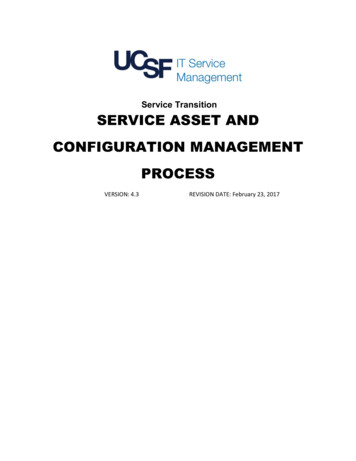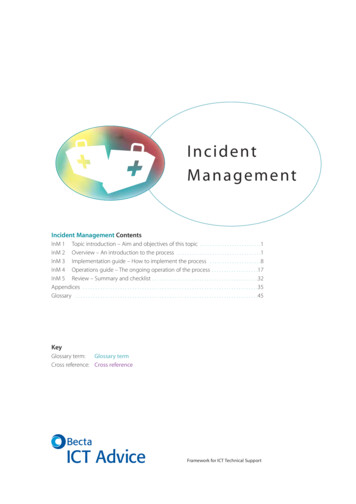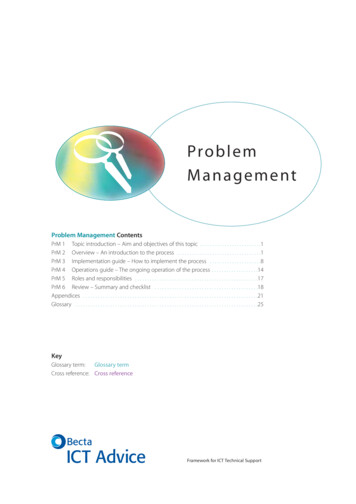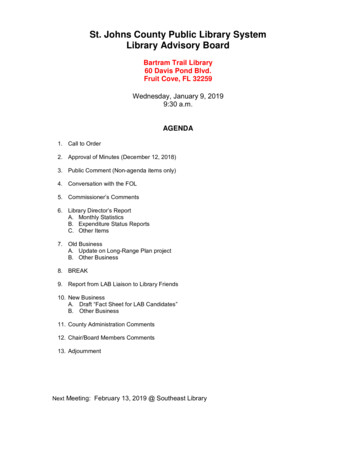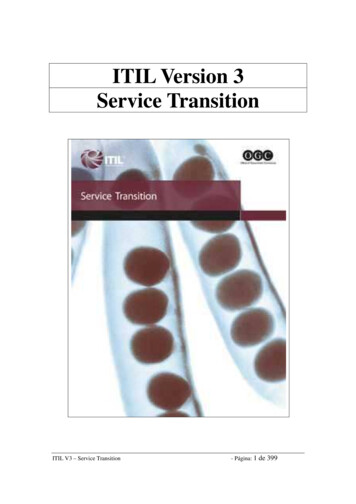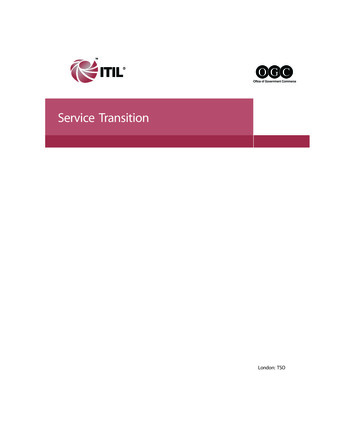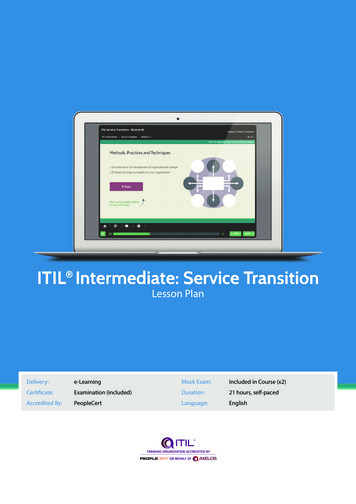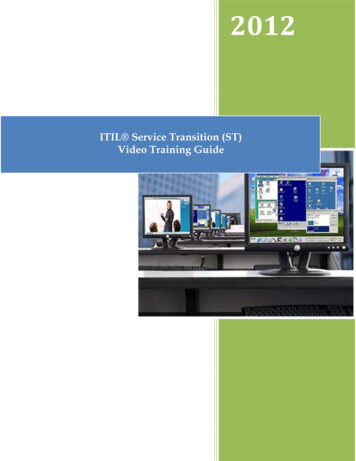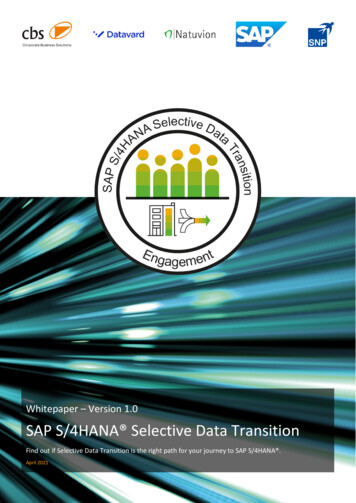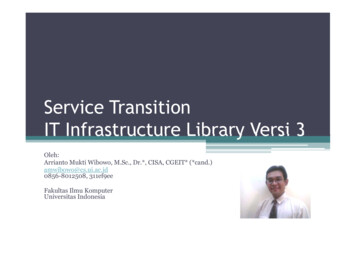
Transcription
Service TransitionIT Infrastructure Library Versi 3Oleh:Arrianto Mukti Wibowo, M.Sc., Dr.*, CISA, CGEIT* (*cand.)amwibowo@cs.ui.ac.id0856-8012508, 311ef9eeFakultas Ilmu KomputerUniversitas Indonesia
Sumber:“An Introductory Overview of ITIL v3” version1.0, UK Chapter of itSMF
Isi Publikasi Inti (Core) ITIL v3
Kegunaan “Service Transition” The role of Service Transition is to deliverservices that are required by the business intooperational use. Service Transition delivers this by receiving theService Design Package from the Service Designstage and delivering into the operational stageevery necessary element required for ongoingoperation and support of that service.
Prinsip-prinsip Service Transition Understanding all services, their utility and warranties - totransition a service effectively it is essential to know its natureand purpose in terms of the outcomes and/or removedbusiness constraints (utilities) and the assurances that theutilities will be delivered (warranties). Establishing a formal policy and common framework forimplementation of all required changes - consistency andcomprehensiveness ensure that no services, stakeholders,occasions etc. are missed out and so cause service failures. Supporting knowledge transfer, decision support and re-useof processes, systems and other elements – effective ServiceTransition is delivered by involving all relevant parties,ensuring appropriate knowledge is available and that workdone is reusable in future similar circumstances.
Prinsip-prinsip (2) Anticipating and managing ‘course corrections’– being proactive and determining likely coursecorrection requirements, and when elements of aservice do need to be adjusted, this isundertaken logically and is fully documented. Ensuring involvement of Service Transition andService Transition requirements throughout theservice lifecycle.
Change Management Change Management ensures that changes are recorded,evaluated, authorized, prioritized, planned, tested,implemented, documented and reviewed in a controlledmanner. The purpose of the Change Management process is toensure that standardized methods are used for the efficient and prompthandling of all changes, all changes are recorded in the Configuration ManagementSystem and overall business risk is optimized. Change management dilakukan pada lapis strategis,taktis dan operasional Mengurangi “error” pada peluncuran layanan baru atauperubahan layanan.
Service Change the addition, modification or removal of anauthorised, planned or supported service orservice component and its associateddocumentation.
Hubungan Change Management dgnConfiguration Management
Ruang LingkupChange & Release Management
Service Asset and ConfigurationManagement (SACM) The purpose of SACM is to identify, control andaccount for service assets and configurationitems (CI), protecting and ensuring theirintegrity across the service lifecycle To manage large and complex IT services andinfrastructures, SACM requires the use of asupporting system known as the ConfigurationManagement System (CMS).
Aktifitas Configuration Management
Contoh breakdown dalam sebuahConfiguration Mgt ‘End User Computing’
Knowledge Management The purpose of Knowledge Management is toensure that the right person has the rightknowledge, at the right time to deliver andsupport the services required by the business Manfaatnya: more efficient services with improved quality clear and common understanding of the valueprovided by services relevant information that is always available.
Transition Planning and Support plan and coordinate resources to ensure that therequirements of Service Strategy encoded inService Design are effectively realized in ServiceOperations identify, manage and control the risks of failureand disruption across transition activities.
Release and DeploymentManagement The goal of the Release and DeploymentManagement process is to assemble and positionall aspects of services into production andestablish effective use of new or changed services It covers the whole assembly andimplementation of new/changed services foroperational use, from release planning throughto early life support.
Service Validation and Testing Successful testing depends on understanding the serviceholistically – how it will be used and the way it isconstructed. All services – whether in-house or bought-in – will needto be tested appropriately, providing validation thatbusiness requirements can be met in the full range ofexpected situations, to the extent of agreed business risk. The key purpose of service validation and testing is toprovide objective evidence that the new/changed servicesupports the busicx ness requirements, including theagreed SLAs. The service is tested explicitly against the utilities andwarranties set out in the service design package,including business functionality, availability, continuity,security, usability and regression testing.
Evaluation Ensuring that the service will be useful to thebusiness is central to successful ServiceTransition and this extends into ensuring thatthe service will continue to be relevant byestablishing appropriate metrics andmeasurement techniques. Evaluation considers the input to ServiceTransition, addressing the relevance of theservice design, the transition approach itself,and the suitability of the new or changed servicefor the actual operational and businessenvironments encountered and expected.
Service Transition IT Infrastructure Library Versi 3 Oleh: Arrianto Mukti Wibowo, M.Sc., Dr.*, CISA, CGEIT* (*cand.) amwibowo@cs.ui.ac.id 0856-8012508, 311ef9ee Fakultas Ilmu Komputer Universitas Indonesia Sumber: “An Introductory Overview of ITIL v3” version 1.0, UK Chapter of itSMF. Isi Publikasi Inti (Core) ITIL v3 . Kegunaan “Service Transition” The role of Service .

